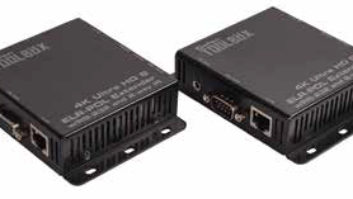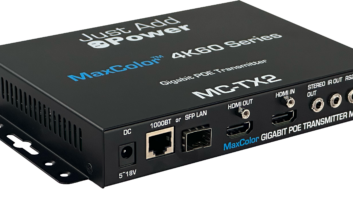The Universal Serial Bus (USB) has had a profound impact in helping AV integrators design and install efficient solutions for residential and commercial clients. Today, data transfer speeds over USB equal the latest HDMI specification; however some limitations to the USB ecosystem present challenges for integrators that are important to identify and understand.

As the adoption of USB became widespread and expanded to its fourth generation as of 2022, connector types became smaller in order to bring compact devices into the fold. USB Type-C and Intel’s Thunderbolt 3 and Thunderbolt 4 are identical in form factor, with Thunderbolt essentially a superset of USB-C. While universal to a great degree, device capabilities determine the advantages each possesses. Thunderbolt 4 supports the bandwidth requirement for PCle before link, support for dual 4K or a single 8K display, Intel VT-d-based protection against direct memory attacks, and power delivery.
With USB enhancements making high transfer rate capabilities available, what realistic applications might this present to commercial and residential integrators? Unfortunately, few practical custom installation scenarios have emerged beyond webcam and KVM control despite USB’s meteoric climb into accelerated data transfer rates. Additionally, competition-level gamers find that Thunderbolt 4 docks consolidate wiring for their required peripherals with no penalty in speed or latency.
Cable Lengths and Signal Stability
One of the main limitations of USB is that Thunderbolt 4 cables have a maximum length of 2 meters, and USB 2.0 has an inherent 5-meter passive cable limitation. Innovative cable designs have made lengths as great as 25 to 30 meters possible; however, they don’t provide a universal solution for all USB application issues. Some USB 3.0 designs employ fiber for distance extension but lack a provision to power endpoint devices where required. Additionally, they can be confusingly proprietary, not supporting USB 2.0 and lower USB versions — and fixed-length cables may lead to untidy installations.
USB 2.0 lengths up to 40 meters are possible, but the effect on data transfer must be considered when specified for an intended application. USB 2.0 High Speed has a maximum data transfer rate of 480 Mb/s, but this includes protocol overhead. Net data transfer rates for USB 2.0, particularly for a device that is bandwidth traffic-intensive such as a USB 3.2 webcam, may have 320 Mb/s or less available to utilize for sending a motion-fluid artifact-free image. If the distance exceeds the 10-meter limit for USB 3.0 cables and a USB 2.0 extension is required, the USB 3.0 device will operate at a USB 2.0 host speed. Integrators must be aware that signal stability is often jeopardized.
Powerful Tools
One useful solution may lie in a new innovative chipset implemented into HDBaseT Spec 3.0 that can achieve distances as great as 100 meters. Though this technology is incapable of augmenting USB data capacity beyond 320 M/bs (HDBaseT Spec 3.0; HDBaseT Spec 2.0 supports up to 190 M/bs), it could be a powerful tool to overcome the most common distance-related challenges encountered by AV integrators. This solution is compliant with USB 2.0 specifications, supporting Isochronous, Interrupt, Bulk, and Control USB transfers for up to seven USB devices, with the HDBaseT RX device on the far side of the link capable of providing hub functionality. Portions of this process are accomplished in firmware, with hardware acceleration to enhance overall performance. This gives integrators a prevailing solution to USB distance limitations for traditional isochronous webcams with bidirectional video and audio applications. Trouble-free KVM Interrupt transfers for classroom, security, banking, and control room projects may confidently be specified, installed, and commissioned.
Limitations of Using 1G AV-over-IP Systems
In 1G AV-over-IP systems with USB features, some facets of USB Interrupt transfer may be employed for KVM applications. 1G AVoIP systems are not blessed with a generous amount of bandwidth, and many do not support USB 2.0 High Speed for time-sensitive devices such as microphones or digital cameras. More recent chip sets may provide higher bandwidth, but most still only offer support for one isochronous transfer device. While some videoconferencing bars may serve as a hub and possibly parse data through stream pipes to function as intended, anticipated performance would likely prove unpredictable and are not recommended for 1G AVoIP applications.
Reliability and Predictability Available Today
USB has dominated connectivity across nearly every electronic platform. While USB hasn’t displaced HDMI for home entertainment purposes (Thunderbolt 4 cable length of 2 meters is a primary reason), the time may come in the not-too-distant future when this obstacle is overcome. In the present, solutions do exist for integrators to send audio with video signals across a room or a soccer field with reliability and predictability. In line with each AV integrator’s methods and best practices, it is advised to pre-test cables and devices to ensure proper performance and compatibility before attempting site deployment. Integrators should always procure products from reputable manufacturers that offer support and a strong warranty.
Michael Hamilton is a longtime AV industry veteran across many disciplines, working for AVPro as the technical writer and with Murideo for Imaging Science Foundation-related activities.






